Recovering Sustainable Mobility after COVID-19: The Case of Almeria (Spain)
Abstract
:1. Introduction
1.1. Context
1.2. Literature Review
1.3. Methodology Context
2. Materials and Methods
3. Results
3.1. Multiple Correspondence Analysis
3.2. Average Vehicle Occupancy
3.3. Frequency
3.4. Length of Bus Line
3.5. Qualitative Variables
4. Discussion
5. Conclusions
Author Contributions
Funding
Data Availability Statement
Acknowledgments
Conflicts of Interest
References
- De Gruyter, C.; Currie, G.; Rose, G. Sustainability measures of urban public transport in cities: A world review and focus on the Asia/Middle East Region. Sustainability 2016, 9, 43. [Google Scholar] [CrossRef]
- Wu, H.; Avner, P.; Boisjoly, G.; Braga, C.K.; El-Geneidy, A.; Huang, J.; Kerzhner, T.; Murphy, B.; Niedzielski, M.A.; Pereira, R.H.M.; et al. Urban access across the globe: An international comparison of different transport modes. NPJ Urban Sustain. 2021, 1, 16. [Google Scholar] [CrossRef]
- Guzman, L.A.; Hessel, P. The effects of public transport subsidies for lower-income users on public transport use: A quasi-experimental study. Transp. Policy 2022, 126, 215–224. [Google Scholar] [CrossRef]
- Yang, B.; Wu, G. Multi-criteria analysis of cross-regional railways interconnection under the post COVID-19 pandemic crisis: A hybrid BWM-FAISM-DFS evaluation framework. Transp. Res. Part E Logist. Transp. Rev. 2023, 179, 103316. [Google Scholar] [CrossRef]
- Nordbakke, S.T.D. Changes in travel behaviour during the pandemic: Exploring why public transport is not back to pre-pandemic levels. Findings 2022. [Google Scholar] [CrossRef]
- Beck, M.J.; Nelson, J.D.; Hensher, D.A. Attitudes toward public transport post Delta COVID-19 lockdowns: Identifying user segments and policies to restore confidence. Int. J. Sustain. Transp. 2023, 17, 827–844. [Google Scholar] [CrossRef]
- Thomas, N.; Jana, A.; Bandyopadhyay, S. Physical distancing on public transport in Mumbai, India: Policy and planning implications for unlock and post-pandemic period. Transp. Policy 2022, 116, 217–236. [Google Scholar] [CrossRef]
- Galeazzi, A.; Cinelli, M.; Bonaccorsi, G.; Pierri, F.; Schmidt, A.L.; Scala, A.; Pammolli, F.; Quattrociocchi, W. Human mobility in response to COVID-19 in France, Italy and UK. Sci. Rep. 2021, 11, 13141. [Google Scholar] [CrossRef]
- Bucsky, P. Modal share changes due to COVID-19: The case of Budapest. Transp. Res. Interdiscip. Perspect. 2020, 8, 100141. [Google Scholar] [CrossRef]
- Rodríguez González, A.B.; Wilby, M.R.; Vinagre Díaz, J.J.; Fernández Pozo, R. Characterization of COVID-19′s impact on mobility and short-term prediction of public transport demand in a mid-size city in Spain. Sensors 2021, 21, 6574. [Google Scholar] [CrossRef]
- Kim, S.; Lee, S.; Ko, E.; Jang, K.; Yeo, J. Changes in car and bus usage amid the COVID-19 pandemic: Relationship with land use and land price. J. Transp. Geogr. 2021, 96, 103168. [Google Scholar] [CrossRef]
- Sung, H. Impacts of the Outbreak and Proliferation of the Middle East Respiratory Syndrome on Rail Transit Ridership in the Seoul Metropolitan City. J. Korea Plan. Assoc. 2016, 51, 163. [Google Scholar] [CrossRef]
- Wang, K.Y. How change of public transportation usage reveals fear of the SARS virus in a city. PLoS ONE 2014, 9, e89405. [Google Scholar] [CrossRef]
- Falchetta, G.; Noussan, M. The impact of COVID-19 on transport demand, modal choices, and sectoral energy consumption in Europe. IAEE Energy Forum 2020, 2020, 48–50. [Google Scholar] [CrossRef]
- Zhang, J.; Hayashi, Y. Research frontier of COVID-19 and passenger transport: A focus on policymaking. Transp. Policy 2022, 119, 78–88. [Google Scholar] [CrossRef]
- Echaniz, E.; Rodríguez, A.; Cordera, R.; Benavente, J.; Alonso, B.; Sañudo, R. Behavioural changes in transport and future repercussions of the COVID-19 outbreak in Spain. Transp. Policy 2021, 111, 38–52. [Google Scholar] [CrossRef] [PubMed]
- Abdullah, M.; Dias, C.; Muley, D.; Shahin, M. Exploring the Impacts of COVID-19 on Travel Behavior and Mode Preferences. Transp. Res. Interdiscip. Perspect. 2020, 8, 100255. [Google Scholar] [CrossRef] [PubMed]
- Scorrano, M.; Danielis, R. Active mobility in an Italian city: Mode choice determinants and attitudes before and during the COVID-19 emergency. Res. Transp. Econ. 2021, 86, 101031. [Google Scholar] [CrossRef]
- Teixeira, J.F.; Lopes, M. The link between bike sharing and subway use during the COVID-19 pandemic: The case-study of New York’s Citi Bike. Transp. Res. Interdiscip. Perspect. 2020, 6, 100166. [Google Scholar] [CrossRef]
- Eisenmann, C.; Nobis, C.; Kolarova, V.; Lenz, B.; Winkler, C. Transport mode use during the COVID-19 lockdown period in Germany: The car became more important, public transport lost ground. Transp. Policy 2021, 103, 60–67. [Google Scholar] [CrossRef]
- Ciuffini, F.; Tengattini, S.; Bigazzi, A.Y. Mitigating increased driving after the COVID-19 pandemic: An analysis on mode share, travel demand, and public transport capacity. Transp. Res. Rec. 2023, 2677, 154–167. [Google Scholar] [CrossRef] [PubMed]
- Przybylowski, A.; Stelmak, S.; Suchanek, M. Mobility behaviour in view of the impact of the COVID-19 pandemic—Public transport users in Gdansk case study. Sustainability 2021, 13, 364. [Google Scholar] [CrossRef]
- Zhang, J.; Hayashi, Y.; Frank, L.D. COVID-19 and transport: Findings from a world-wide expert survey. Transp. Policy 2021, 103, 68–85. [Google Scholar] [CrossRef] [PubMed]
- Fernández Pozo, R.F.; Wilby, M.R.; Díaz JJ, V.; González AB, R. Data-driven analysis of the impact of COVID-19 on Madrid’s public transport during each phase of the pandemic. Cities 2022, 127, 103723. [Google Scholar] [CrossRef] [PubMed]
- Griffiths, S.; Del Rio, D.F.; Sovacool, B. Policy mixes to achieve sustainable mobility after the COVID-19 crisis. Renew. Sustain. Energy Rev. 2021, 143, 110919. [Google Scholar] [CrossRef] [PubMed]
- Campisi, T.; Basbas, S.; Skoufas, A.; Akgün, N.; Ticali, D.; Tesoriere, G. The impact of COVID-19 pandemic on the resilience of sustainable mobility in Sicily. Sustainability 2020, 12, 8829. [Google Scholar] [CrossRef]
- De Haas, M.; Faber, R.; Hamersma, M. How COVID-19 and the Dutch ‘intelligent lockdown’ change activities, work and travel behaviour: Evidence from longitudinal data in the Netherlands. Transp. Res. Interdiscip. Perspect. 2020, 6, 100150. [Google Scholar] [CrossRef] [PubMed]
- Nikiforiadis, A.; Mitropoulos, L.; Kopelias, P.; Basbas, S.; Stamatiadis, N.; Kroustali, S. Exploring mobility pattern changes between before, during and after COVID-19 lockdown periods for young adults. Cities 2022, 125, 103662. [Google Scholar] [CrossRef]
- Nikiforiadis, A.; Paschalidis, E.; Stamatiadis, N.; Raptopoulou, A.; Kostareli, A.; Basbas, S. Analysis of attitudes and engagement of shared e-scooter users. Transp. Res. Part D Transp. Environ. 2021, 94, 102790. [Google Scholar] [CrossRef]
- Lucchesi, S.T.; Tavares, V.B.; Rocha, M.K.; Larranaga, A.M. Public transport COVID-19-safe: New barriers and policies to implement effective countermeasures under user’s safety perspective. Sustainability 2022, 14, 2945. [Google Scholar] [CrossRef]
- Sharifi, A.; Khavarian-Garmsir, A.R. The COVID-19 pandemic: Impacts on cities and major lessons for urban planning, design, and management. Sci. Total Environ. 2020, 749, 142391. [Google Scholar] [CrossRef]
- Hu, S.; Chen, P. Who left riding transit? Examining socioeconomic disparities in the impact of COVID-19 on ridership. Transp. Res. Part D Transp. Environ. 2021, 90, 102654. [Google Scholar] [CrossRef]
- Liu, L.; Miller, H.J.; Scheff, J. The impacts of COVID-19 pandemic on public transit demand in the United States. PLoS ONE 2020, 15, e0242476. [Google Scholar] [CrossRef]
- Jiao, J.; Hansen, K.; Azimian, A. Disparities in the Impacts of the COVID-19 Pandemic on Public Transit Ridership in Austin, Texas, USA. Transp. Res. Rec. 2023, 2677, 287–297. [Google Scholar] [CrossRef]
- Vega-Gonzalo, M.; Gomez, J.; Christidis, P. How has COVID-19 changed private car use in European urban areas? An analysis of the effect of socio-economic characteristics and mobility habits. Transp. Res. Part A Policy Pract. 2023, 172, 103679. [Google Scholar] [CrossRef] [PubMed]
- Pawar, D.S.; Yadav, A.K.; Akolekar, N.; Velaga, N.R. Impact of physical distancing due to novel coronavirus (SARS-CoV-2) on daily travel for work during transition to lockdown. Transp. Res. Interdiscip. Perspect. 2020, 7, 100203. [Google Scholar] [CrossRef]
- Dueñas, M.; Campi, M.; Olmos, L.E. Changes in mobility and socioeconomic conditions during the COVID-19 outbreak. Humanit. Soc. Sci. Commun. 2021, 8, 101. [Google Scholar] [CrossRef]
- Orro, A.; Novales, M.; Monteagudo, Á.; Pérez-López, J.B.; Bugarín, M.R. Impact on city bus transit services of the COVID–19 lockdown and return to the new normal: The case of A Coruña (Spain). Sustainability 2020, 12, 7206. [Google Scholar] [CrossRef]
- Aparicio, J.T.; Arsenio, E.; Henriques, R. Understanding the impacts of the COVID-19 pandemic on public transportation travel patterns in the City of Lisbon. Sustainability 2021, 13, 8342. [Google Scholar] [CrossRef]
- Gkiotsalitis, K.; Cats, O. Public transport planning adaption under the COVID-19 pandemic crisis: Literature review of research needs and directions. Transp. Rev. 2021, 41, 374–392. [Google Scholar] [CrossRef]
- Caramuta, C.; Giacomini, C.; Longo, G.; Poloni, C. Managerial decisions to recover from COVID-19 disruption: A multi-objective optimization approach applied to public transport operators. Transp. Eng. 2023, 11, 100163. [Google Scholar] [CrossRef]
- Nikolaidou, A.; Kopsacheilis, A.; Georgiadis, G.; Noutsias, T.; Politis, I.; Fyrogenis, I. Factors affecting public transport performance due to the COVID-19 outbreak: A worldwide analysis. Cities 2023, 134, 104206. [Google Scholar] [CrossRef] [PubMed]
- Aloi, A.; Alonso, B.; Benavente, J.; Cordera, R.; Echániz, E.; González, F.; Ladisa, C.; Lezama-Romanelli, R.; López-Parra, Á.; Mazzei, V.; et al. Effects of the COVID-19 lockdown on urban mobility: Empirical evidence from the city of Santander (Spain). Sustainability 2020, 12, 3870. [Google Scholar] [CrossRef]
- Tirachini, A.; Cats, O. COVID-19 and public transportation: Current assessment, prospects, and research needs. J. Public Transp. 2020, 22, 1–21. [Google Scholar] [CrossRef] [PubMed]
- Wagner, A.; Ibold, S.; Medimorec, N. The COVID-19 Outbreak and Implications to Sustainable Urban Mobility; Sustain. Transport.; SloCaT: Brussels, Belgium, 2020. [Google Scholar]
- Potter, S.; Enoch, M.; Valdez Juarez, A.; Cook, M. Demand Responsive Transport: Is Milton Keynes developing a post-COVID revolution in public transport? In Proceedings of the Universities Transport Study Group Annual Conference, Online, 5–6 July 2021. [Google Scholar]
- Parady, G.; Taniguchi, A.; Takami, K. Analyzing risk perception and social influence effects on self-restriction Behavior in response to the COVID-19 pandemic in Japan: First results. Transp. Res. Interdiscip. Perspect. 2020, 7, 100181. [Google Scholar] [CrossRef]
- Macioszek, E.; Kurek, A. Extracting road traffic volume in the city before and during COVID-19 through video remote sensing. Remote Sens. 2021, 13, 2329. [Google Scholar] [CrossRef]
- Chen, L.; Grimstead, I.; Bell, D.; Karanka, J.; Dimond, L.; James, P.; Smith, L.; Edwardes, A. Estimating vehicle and pedestrian activity from town and city traffic cameras. Sensors 2021, 21, 4564. [Google Scholar] [CrossRef]
- Jenelius, E.; Cebecauer, M. Impacts of COVID-19 on public transport ridership in Sweden: Analysis of ticket validations, sales and passenger counts. Transp. Res. Interdiscip. Perspect. 2020, 8, 100242. [Google Scholar]
- Das, S.; Boruah, A.; Banerjee, A.; Raoniar, R.; Nama, S.; Maurya, A.K. Impact of COVID-19: A radical modal shift from public to private transport mode. Transp. Policy 2021, 109, 1–11. [Google Scholar] [CrossRef]
- Fatmi, M.R. COVID-19 impact on urban mobility. J. Urban Manag. 2020, 9, 270–275. [Google Scholar] [CrossRef]
- Qi, Y.; Liu, J.; Tao, T.; Zhao, Q. Impacts of COVID-19 on public transit ridership. Int. J. Transp. Sci. Technol. 2023, 12, 34–45. [Google Scholar] [CrossRef]
- Wilbur, M.; Ayman, A.; Sivagnanam, A.; Ouyang, A.; Poon, V.; Kabir, R.; Vadali, A.; Pugliese, P.; Freudberg, D.; Laszka, A.; et al. Impact of COVID-19 on public transit accessibility and ridership. Transp. Res. Rec. 2023, 2677, 531–546. [Google Scholar] [CrossRef]
- Harantová, V.; Kalašová, A.; Skřivánek Kubíková, S.; Mazanec, J.; Jordová, R. The impact of mobility on shopping preferences during the COVID-19 Pandemic: The evidence from the Slovak Republic. Mathematics 2022, 10, 1394. [Google Scholar] [CrossRef]
- Štefancová, V.; Kalašová, A.; Čulík, K.; Mazanec, J.; Vojtek, M.; Mašek, J. Research on the impact of COVID-19 on micromobility using statistical methods. Appl. Sci. 2022, 12, 8128. [Google Scholar] [CrossRef]
- Rauws, R.; van Lierop, D. Returning to public transit after an epidemic. Findings 2020. [Google Scholar] [CrossRef]
- De Borger, B.; Proost, S. COVID-19 and optimal urban transport policy. Transp. Res. Part A Policy Pract. 2022, 163, 20–42. [Google Scholar] [CrossRef] [PubMed]
- Kraus, S.; Koch, N. Provisional COVID-19 infrastructure induces large, rapid increases in cycling. Proc. Natl. Acad. Sci. USA 2021, 118, e2024399118. [Google Scholar] [CrossRef] [PubMed]
- Büchel, B.; Marra, A.D.; Corman, F. COVID-19 as a window of opportunity for cycling: Evidence from the first wave. Transp. Policy 2022, 116, 144–156. [Google Scholar] [CrossRef]
- Fitzpatrick, K.; Brewer, M.A.; Turner, S. Another look at pedestrian walking speed. Transp. Res. Rec. 2006, 1982, 21–29. [Google Scholar] [CrossRef]
- Mohamed, A.; Bigazzi, A. Speed and road grade dynamics of urban trips on electric and conventional bicycles. Transp. B Transp. Dyn. 2019, 7, 1467–1480. [Google Scholar] [CrossRef]
- Zhao, P.; Gao, Y. Public transit travel choice in the post COVID-19 pandemic era: An application of the extended Theory of Planned behavior. Travel Behav. Soc. 2022, 28, 181–195. [Google Scholar] [CrossRef] [PubMed]
- Downey, L.; Fonzone, A.; Fountas, G.; Semple, T. The impact of COVID-19 on future public transport use in Scotland. Transp. Res. Part A Policy Pract. 2022, 163, 338–352. [Google Scholar] [CrossRef] [PubMed]
- Astroza, S.; Tirachini, A.; Hurtubia, R.; Carrasco, J.A.; Guevara, A.; Munizaga, M.; Figueroa, M.; Torres, V. Mobility changes, teleworking, and remote communication during the COVID-19 pandemic in Chile. Findings 2020. [Google Scholar] [CrossRef]
- Basnak, P.; Giesen, R.; Muñoz, J.C. Estimation of crowding factors for public transport during the COVID-19 pandemic in Santiago, Chile. Transp. Res. Part A Policy Pract. 2022, 159, 140–156. [Google Scholar] [CrossRef]
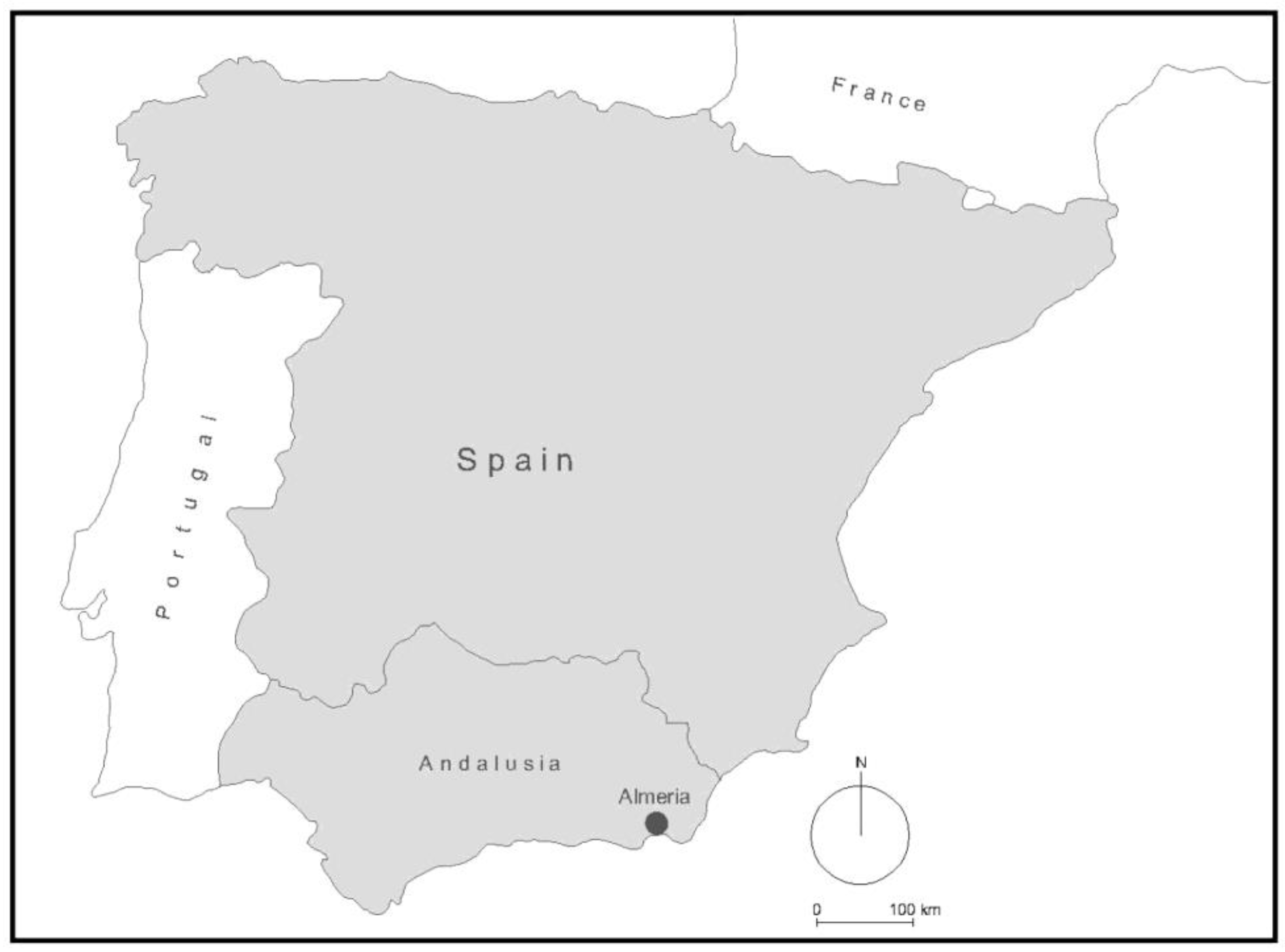

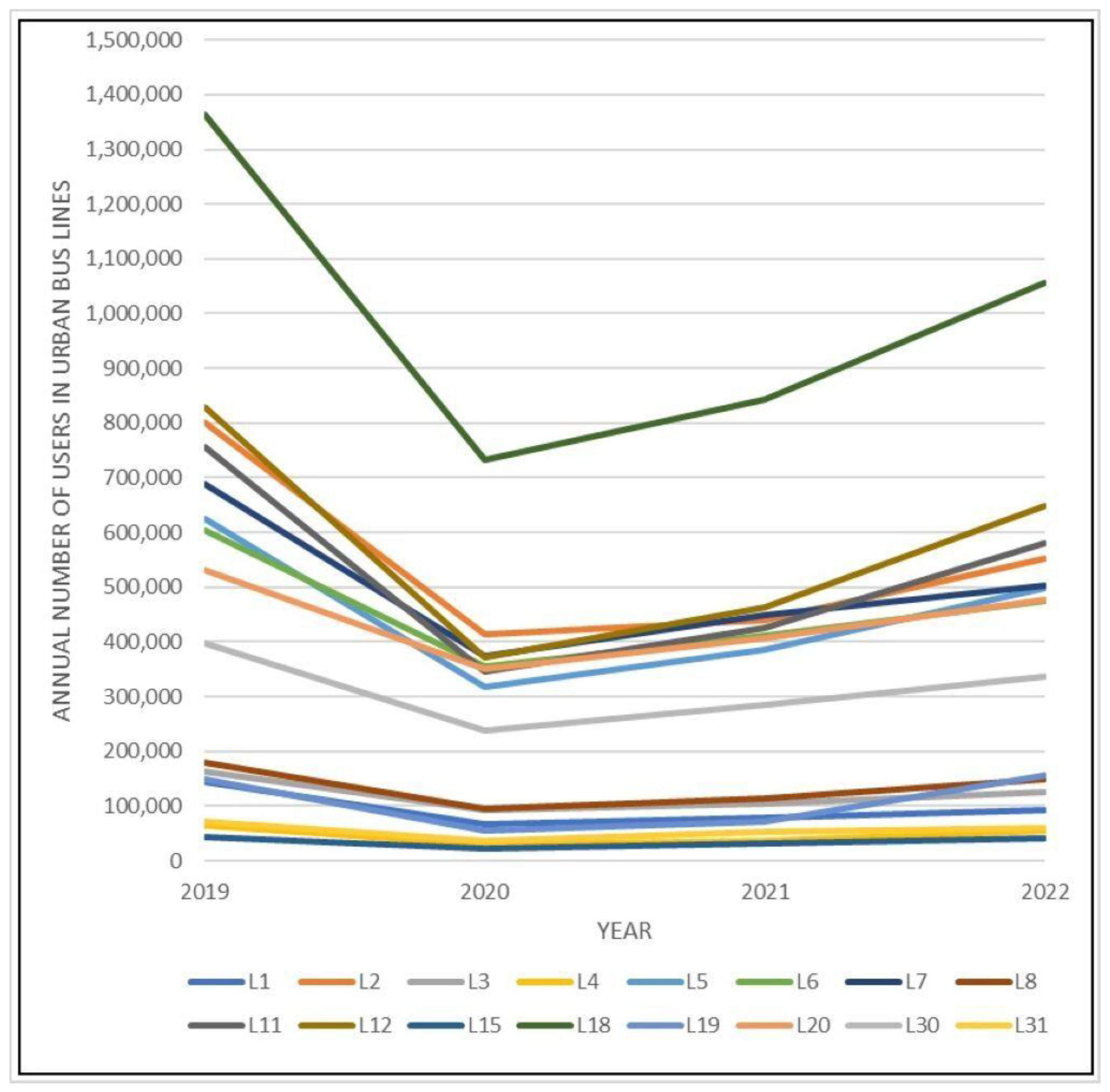
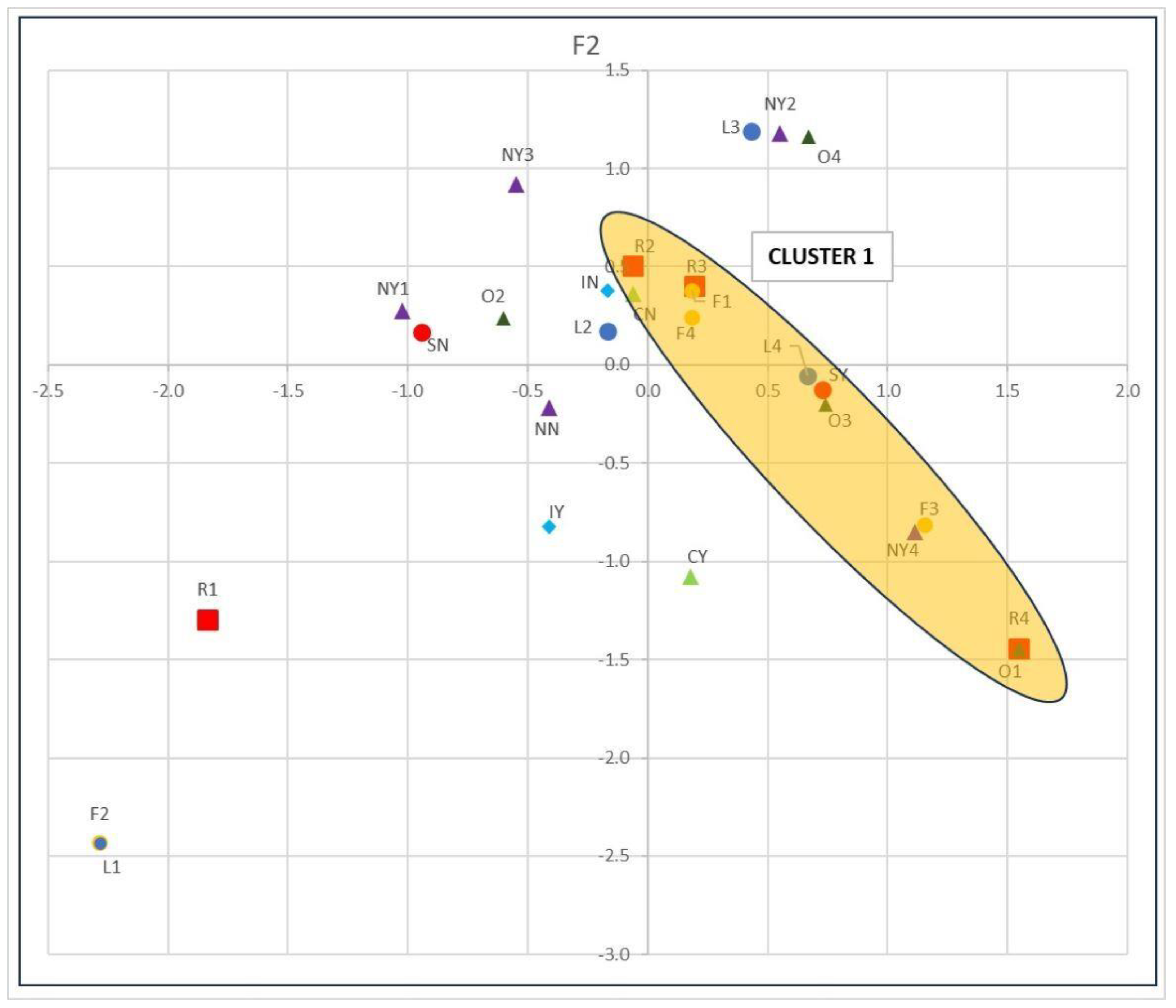
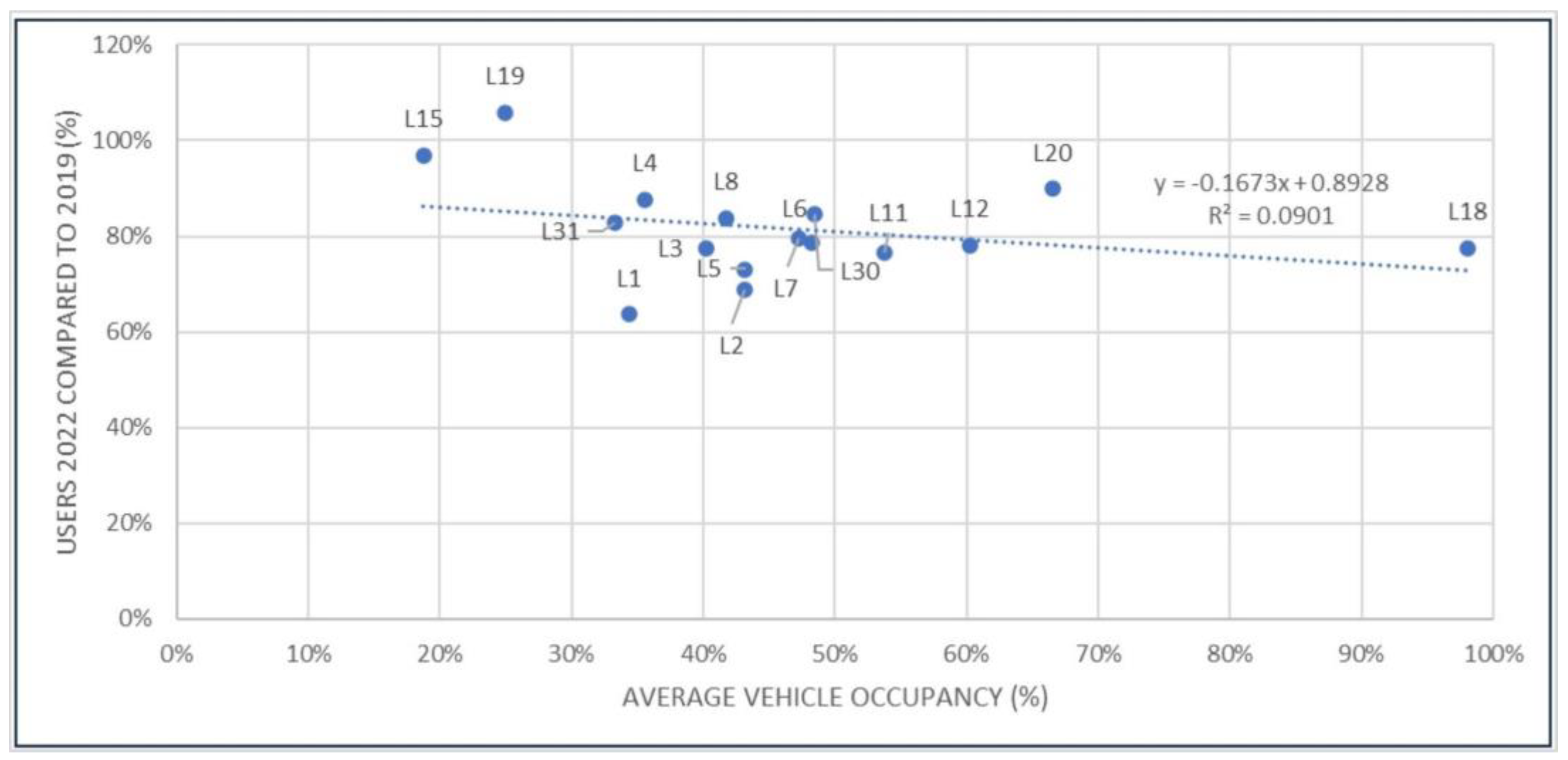
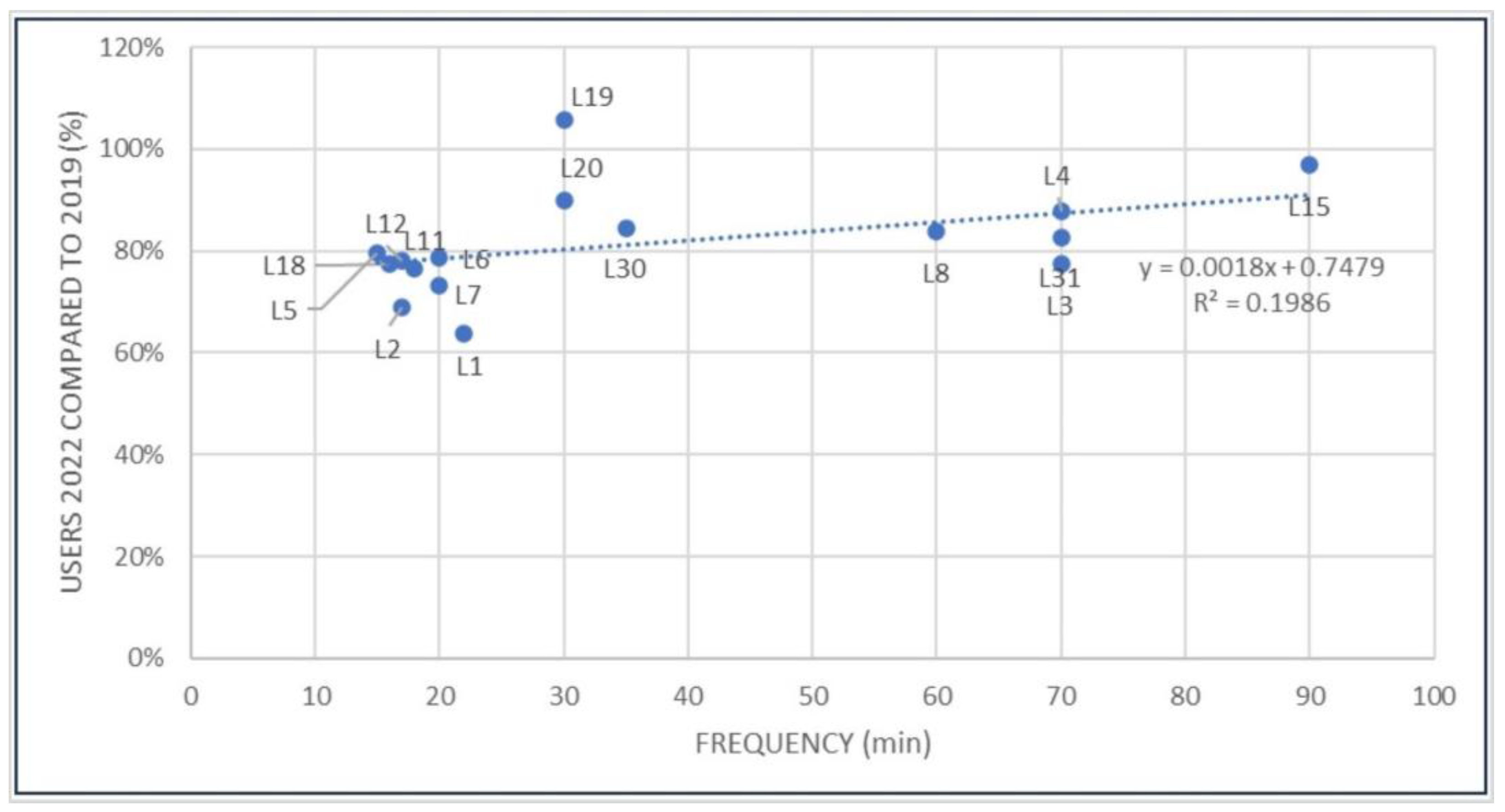
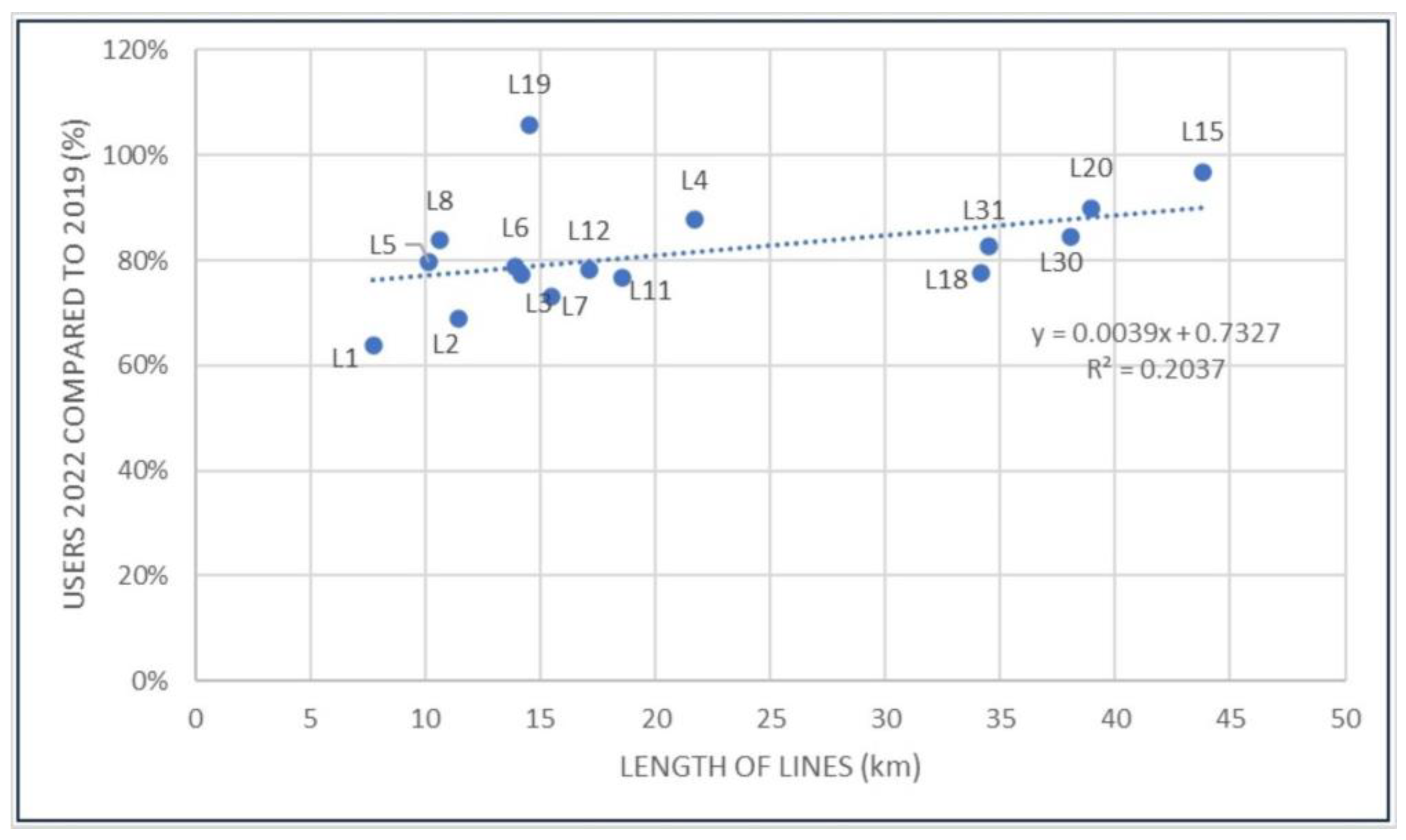
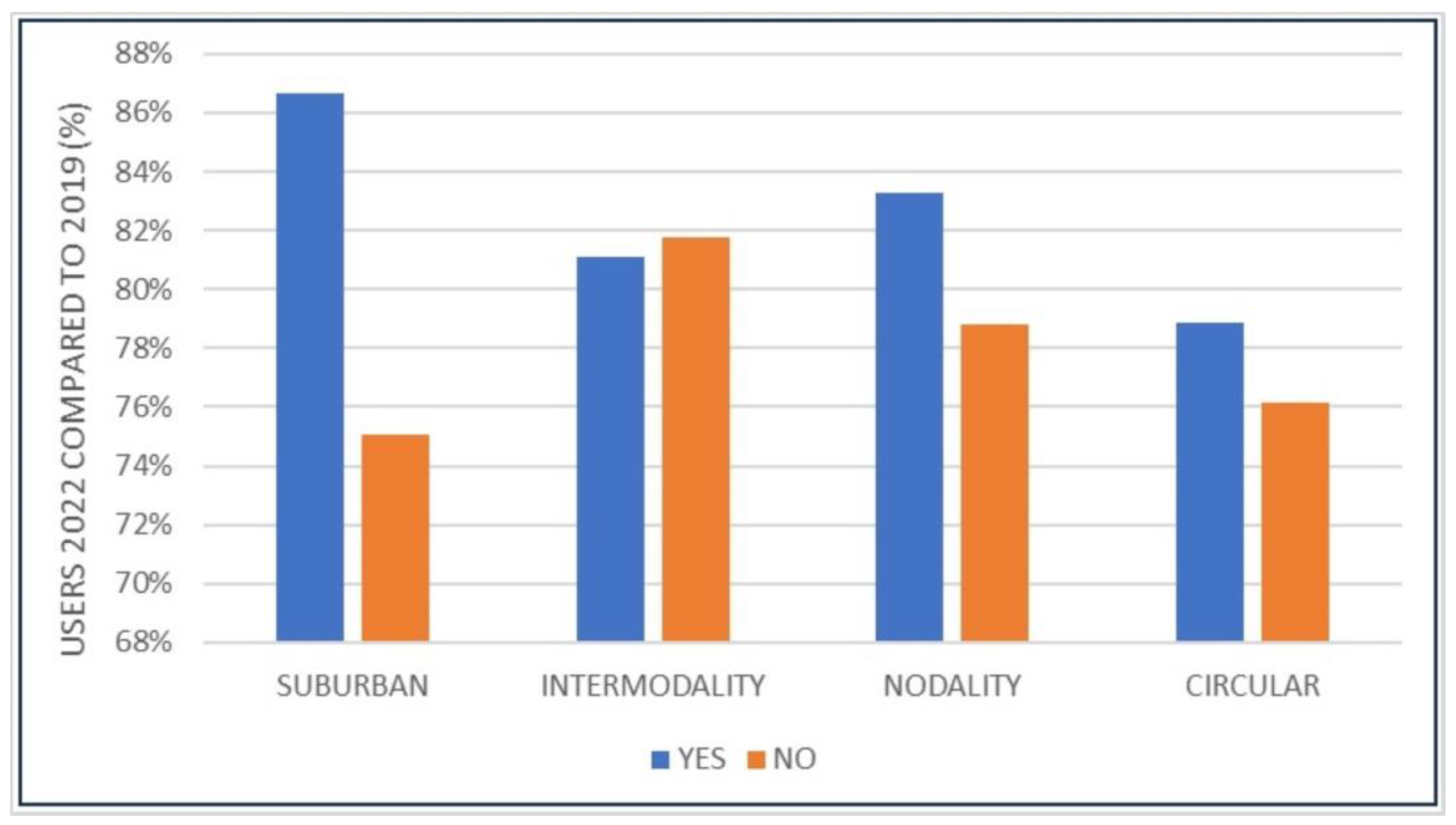
| Year | ||||
|---|---|---|---|---|
| 2019 | 2020 | 2021 | 2022 | |
| Annual users | 7,410,583 | 3,898,098 | 4,601,237 | 5,810,103 |
| % annual users compared to 2019 | 100% | 53% | 62% | 78% |
| Service Variables | ||||||||||
|---|---|---|---|---|---|---|---|---|---|---|
| Line | % Vehicle Occupancy 2022 | Frequency (Min) | Suburban | Intermodality | Nodality | Length (km) | Circular | Users (2019) | Users (2022) | % Users Recovered 2022/2019 |
| L1 | 34% | 22 | NO | YES (Bus/train) | NO | 7.733 | YES | 144,543 | 92,072 | 64% |
| L2 | 43% | 17 | NO | YES (Bus/train) | YES (Hosp) | 11.477 | NO | 800,205 | 551,172 | 69% |
| L3 | 40% | 70 | NO | NO | YES (Hosp) | 14.169 | NO | 162,887 | 126,146 | 77% |
| L4 | 36% | 70 | YES | NO | YES (Hosp-Univ) | 21.701 | NO | 63,707 | 55,832 | 88% |
| L5 | 47% | 15 | NO | NO | YES (Mall) | 10.171 | NO | 625,744 | 498,187 | 80% |
| L6 | 48% | 20 | NO | NO | NO | 13.914 | NO | 604,147 | 475,805 | 79% |
| L7 | 43% | 20 | NO | NO | NO | 15.450 | NO | 688,768 | 503,525 | 73% |
| L8 | 42% | 60 | NO | NO | YES (Mall) | 10.632 | NO | 178,711 | 149,747 | 84% |
| L11 | 54% | 18 | YES | NO | YES (Univ) | 18.586 | YES | 755,889 | 579,444 | 77% |
| L12 | 60% | 17 | YES | NO | YES (Univ) | 17.133 | YES | 829,895 | 648,966 | 78% |
| L15 | 19% | 90 | YES | NO | YES (Univ) | 43.820 | YES | 43,278 | 41,935 | 97% |
| L18 | 98% | 16 | YES | NO | YES (Hosp-Univ) | 34.155 | NO | 1,362,526 | 1,056,254 | 78% |
| L19 | 25% | 30 | YES | YES (Bus/train) | YES (Univ) | 14.497 | NO | 148,100 | 156,700 | 106% |
| L20 | 67% | 30 | YES | NO | NO | 38.926 | NO | 531,709 | 478,027 | 90% |
| L30 | 48% | 35 | YES | YES (Bus/train) | NO | 38.024 | NO | 398,304 | 336,617 | 85% |
| L31 | 33% | 70 | YES | YES (Bus/train) | NO | 34.485 | NO | 72,170 | 59,674 | 83% |
| TOTAL | 7,410,583 | 5,810,103 | 78% | |||||||
| Variable | Categories | Coding |
|---|---|---|
| % Users recovered (R) | ≤70% | R1 |
| 70% < x ≤ 80% | R2 | |
| 80% < x ≤ 90% | R3 | |
| >90% | R4 | |
| % Vehicle occupancy 2022 (O) | ≤25% | O1 |
| 25% < x ≤ 50% | O2 | |
| 50% < x ≤ 75% | O3 | |
| >75% | O4 | |
| Frequency (min) (F) | ≤20 | F1 |
| 20 < x ≤ 25 | F2 | |
| 25 < x ≤ 30 | F3 | |
| >30 | F4 | |
| Length of line (km) (L) | ≤10 | L1 |
| 10 < x ≤ 20 | L2 | |
| 20 < x ≤ 30 | L3 | |
| >30 | L4 | |
| Suburban (S) | YES | SY |
| NO | SN | |
| Intermodality (I) | YES | IY |
| NO | IN | |
| Nodality (N) | Hospital | NY1 |
| Hospital/University | NY2 | |
| Mall | NY3 | |
| University | NY4 | |
| NO | NN | |
| Circular (C) | YES | CY |
| NO | CN |
| Dimension | Cronbach’s Alpha | Variance Accounted for | ||
|---|---|---|---|---|
| Total (Singular Value) | Inertia | % Proportion of Inertia | ||
| 1 | 0.839 | 3.756 | 0.469 | 46.947 |
| 2 | 0.790 | 3.243 | 0.405 | 40.535 |
| Total | 6.999 | 0.875 | ||
| Mean | 0.816 | 3.499 | 0.437 | 43.741 |
| Variable | Dimension | Average | |
|---|---|---|---|
| 1 | 2 | ||
| R | 0.734 | 0.634 | 0.684 |
| O | 0.656 | 0.389 | 0.522 |
| F | 0.517 | 0.536 | 0.527 |
| L | 0.492 | 0.475 | 0.484 |
| S | 0.690 | 0.021 | 0.355 |
| I | 0.076 | 0.312 | 0.194 |
| N | 0.580 | 0.488 | 0.534 |
| C | 0.011 | 0.388 | 0.200 |
| Total | 3.756 | 3.243 | 3.499 |
| % Proportion of inertia | 46.947 | 40.535 | 43.741 |
Disclaimer/Publisher’s Note: The statements, opinions and data contained in all publications are solely those of the individual author(s) and contributor(s) and not of MDPI and/or the editor(s). MDPI and/or the editor(s) disclaim responsibility for any injury to people or property resulting from any ideas, methods, instructions or products referred to in the content. |
© 2024 by the authors. Licensee MDPI, Basel, Switzerland. This article is an open access article distributed under the terms and conditions of the Creative Commons Attribution (CC BY) license (https://creativecommons.org/licenses/by/4.0/).
Share and Cite
Garrido-Jiménez, F.J.; Rodríguez-Rojas, M.I.; Vallecillos-Siles, M.R. Recovering Sustainable Mobility after COVID-19: The Case of Almeria (Spain). Appl. Sci. 2024, 14, 1258. https://doi.org/10.3390/app14031258
Garrido-Jiménez FJ, Rodríguez-Rojas MI, Vallecillos-Siles MR. Recovering Sustainable Mobility after COVID-19: The Case of Almeria (Spain). Applied Sciences. 2024; 14(3):1258. https://doi.org/10.3390/app14031258
Chicago/Turabian StyleGarrido-Jiménez, Francisco Javier, María I. Rodríguez-Rojas, and Manuel Ricardo Vallecillos-Siles. 2024. "Recovering Sustainable Mobility after COVID-19: The Case of Almeria (Spain)" Applied Sciences 14, no. 3: 1258. https://doi.org/10.3390/app14031258
APA StyleGarrido-Jiménez, F. J., Rodríguez-Rojas, M. I., & Vallecillos-Siles, M. R. (2024). Recovering Sustainable Mobility after COVID-19: The Case of Almeria (Spain). Applied Sciences, 14(3), 1258. https://doi.org/10.3390/app14031258







